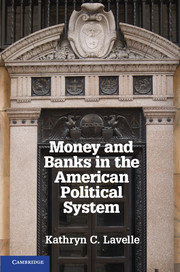Book contents
- Frontmatter
- Contents
- Figures and Tables
- Preface
- Acknowledgments
- Abbreviations
- 1 The Institutional Foundations of Financial Politics in the United States
- Section 1 A Historical Background
- Section 2 Bureaucratic Politics and Finance
- Section 3 The Operation of the Financial Political Economy
- Section 4 Conclusions
- Glossary
- References
- Index
Section 3 - The Operation of the Financial Political Economy
Published online by Cambridge University Press: 05 January 2013
- Frontmatter
- Contents
- Figures and Tables
- Preface
- Acknowledgments
- Abbreviations
- 1 The Institutional Foundations of Financial Politics in the United States
- Section 1 A Historical Background
- Section 2 Bureaucratic Politics and Finance
- Section 3 The Operation of the Financial Political Economy
- Section 4 Conclusions
- Glossary
- References
- Index
Summary
The Operation of the Financial Political Economy
This section picks up the historical review covered in Section One and integrates it with the bureaucratic politics among the president, agencies, and the legislature covered in Section Two to see how the system operates in motion. The stakes of the actors involved are brought into particularly sharp contrast during the business cycle and in a crisis. The process in motion matters because responses to developments in the financial sector and political institutions compel citizens and bankers to make demands on their government for change, as well as for the government to respond. Politics are not static. The process of regulation, institutional competition, and financial innovation thus results in new configurations of state capacity to regulate the financial sector – with one of the most dramatic episodes having occurred in 2008.
The section divides the analysis into the operations of the government in response to the ups and downs of the business cycle, from how it operates in response to a crisis, and from its international context. In these chapters, a crisis is a sporadic, disruptive event that alters the boundaries defining the legitimate use of coercion. Actions taken to meet these challenges often lead to the establishment of new institutional forms, powers and precedents. Chapter 7 explores the politics associated with the business cycle, when the president, Congress, and the Federal Reserve respond to the competing demands of those citizens disadvantaged in a downturn. Each organization responds according to the range of opportunity allowable under its mandate, and change among them is incremental. Even prior to the crisis of 2008, the tendency was for the Federal Reserve to play a greater role in macroeconomic management, and for Congress to cut taxes without raising revenue from other sources. In Chapter 8, we see how the pace of change escalated during the financial crisis of 2008. The chapter divides the government’s response to the crisis into the short term, where it stretched the boundaries of legitimate use of its resources to save the system, and the intermediate term, where the legislature reorganized the regulatory framework and established a new agency for consumer protection.
- Type
- Chapter
- Information
- Money and Banks in the American Political System , pp. 163 - 164Publisher: Cambridge University PressPrint publication year: 2013

